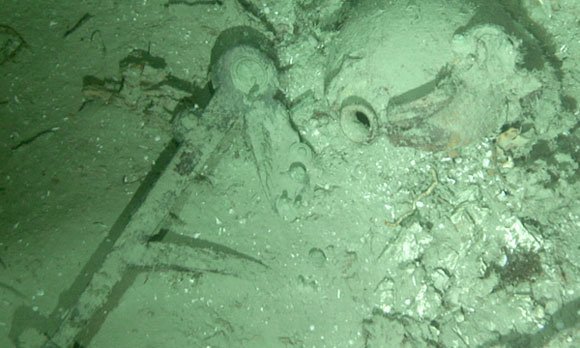The remains of a centuries-old shipwreck have been discovered more than a mile below the surface of the Atlantic Ocean off the coast of North Carolina, a reminder that history can be found anywhere.
A team of researchers stumbled upon the previously unknown wreck, which appears to be from the late 18th or early 19th century. Among the artifacts spotted on the ocean floor were a metal compass, an iron chain, glass bottles, a ceramic jug, ship timbers, red bricks and a navigational tool.
The scientists were searching for a mooring they had left behind on a 2012 research trip when their sonar-scanning system detected a dark area on the ocean floor. They used Alvin, a manned submersible, to locate the wreck on July 12.
“This is an exciting find, and a vivid reminder that even with major advances in our ability to access and explore the ocean, the deep sea holds its secrets close,” said group leader Cindy Van Dover, director of the Duke University Marine Laboratory, in a statement.
Van Dover was joined by Dave Eggleston, director of the Center for Marine Sciences and Technology at North Carolina State University, and James Delgado, director of maritime heritage at National Oceanic & Atmospheric Administration. Scientists from the University of Oregon were also part of the team.
The group was aboard Atlantis, a research ship from the Woods Hole Oceanographic Institution in Woods Hole, Massachusetts. The researchers also used an autonomous underwater vehicle, called Sentry, to help locate the wreck.
In a twist, although the team discovered a piece of maritime history, that abandoned mooring remains missing.
NOAA will try to identify the ship and date the artifacts, which have been preserved by the near-freezing temperatures of the ocean’s depths. Bruce Terrell, chief archaeologist at NOAA’s Maritime Heritage Program, said the organization will use high-definition cameras on a robotic deep-sea vessel to document the artifacts.
These images will be compared with catalogs of historic items. The cameras will also capture how the pieces relate to one another on the ocean floor, which may help reveal their meaning.
“The context of the artifacts are important to understand whether they are cargo or personal belongings,” Terrell said.
For example, the ceramic jug could indicate whether the ship’s origin is American, British or Spanish, Terrell said. An American ship would offer significant insight about the budding country, Delgado said.
“If this wreck is as old as we think it is, it comes at a time when America is between a colony and a republic,” he said. “It’s an exciting period where America is really opening as an independent nation to the rest of the world.”
Identifying the ship and dating the artifacts won’t come until NOAA can secure funding to investigate the wreck, which may take a year.
The process of dating these pieces relies heavily on collaboration between NOAA, oceanographers and marine biologists. A diverse researching partnership benefits other areas of knowledge that remain unknown, such as the ocean floor.
“We know more about the surface of Pluto now than we do about the sea floor off our own coast,” Delgado said. “Any time we find something, it’s going to be interesting.”
